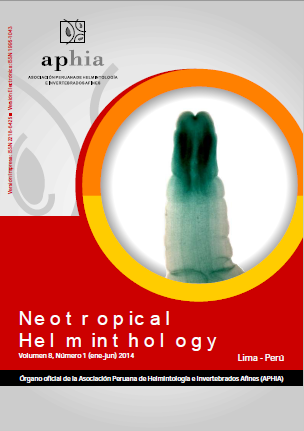APPLICATION TO SMALL-SCALE FIELD OF STEINERNEMA RIOBRAVIS CABANILLAS, POINAR & RAULSTON, 1994 (NEMATODA, STEINERNEMATIDAE), THERMO TRILOGY STRAIN AGAINST NEOCURTILLA CLARAZIANA (SAUSSURE, 1874) (ORTHOPTERA, GRYLLOTALPIDAE) IN GARDENS OF LA PLATA, ARGENTIN
DOI:
https://doi.org/10.24039/rnh201481901Keywords:
Argentina, biocontrol assays, mole cricket, Steinernema riobravis.Abstract
Steinernema riobravis Cabanillas, Poinar & Raulston, 1994, Thermo Trilogy strain (Nematoda, Steinernematidae) was the nematode species used for application to small-scale field against Neocurtilla claraziana (Saussure, 1874) (Orthoptera, Gryllotalpidae), a pest of soil in three gardens of Gran La Plata, Argentina. Assays were performed with dosages of 6,000, 10,000, 20,000, 40,000 and 80,000 nematodes per 3 m2, with a density of 32 ± 7 mole crickets/3 m2. The application was performed with hand sprayer. The percentages of effectiveness varied in different gardens, the first lower dose was 65% ± 15.67 and the highest dose was 83% ± 22.25, with ± 80% being the average dose 18.56. For the second garden 50% ± 8.31 for the low dose and 76% ± 21.15 for medium and higher, and for the third garden the lower dose was 42 ± 15.87%, the highest dose of 66% ± 18.32 and the mean dose of 60 ± 17.92%. We observed in the first three days posttreatment the highest percentages of infection for all doses, on day seven effectiveness for different doses significantly decreased nearing the end of post-treatment (day 31) with 0% for the three trials. This study demonstrated the potential of entomopathogenic nematodes as biological control agents, resulting in the introduced entomonematodo as an effective biological control agent for mole crickets.
Downloads
Published
How to Cite
Issue
Section
License
Copyright (c) 2021 Neotropical Helminthology

This work is licensed under a Creative Commons Attribution-NonCommercial-NoDerivatives 4.0 International License.
OBJETO: El AUTOR-CEDENTE transfiere de manera TOTAL Y SIN LIMITACIÓN alguna al CESIONARIO los derechos patrimoniales que le corresponden sobre la (s) obra(s) tituladas: xxxxxxxxxxxxxxxx, por el tiempo que establezca la ley internacional. En virtud de lo anterior, se entiende que el CESIONARIO adquiere el derecho de reproducción en todas sus modalidades, incluso para inclusión audiovisual; el derecho de transformación o adaptación, comunicación pública, traducción, distribución y, en general, cualquier tipo de explotación que de las obras se pueda realizar por cualquier medio conocido o por conocer en el territorio nacional o internacional.
REMUNERACIÓN: La cesión de los derechos patrimoniales de autor que mediante este contrato se hace será a título gratuito.
CONDICIONES Y LEGITIMIDAD DE LOS DERECHOS: El AUTOR-CEDENTE garantiza que es propietario integral de los derechos de explotación de la(s) obra(s) y en consecuencia garantiza que puede contratar y transferir los derechos aquí cedidos sin ningún tipo de limitación por no tener ningún tipo de gravamen, limitación o disposición. En todo caso, responderá por cualquier reclamo que en materia de derecho de autor se pueda presentar, exonerando de cualquier responsabilidad al CESIONARIO.
LICENCIA DE ACCESO ABIERTO: El AUTOR-CEDENTE autoriza que manuscrito publicado en La Revista Neotropical Helminthology permanece disponible para su consulta pública en el sitio web https://www.neotropicalhelminthology.com/ y en los diferentes sistemas de indexación y bases de datos en las que la revista tiene visibilidad, bajo la licencia Creative Commons, en la modalidad Reconocimiento-No comercial- Sin Trabajos derivados –aprobada en Perú, y por lo tanto son de acceso abierto. De ahí que los autores dan, sin derecho a retribución económica, a la Asociación Peruana de Helmintología e Invertebrados Afines (APHIA), los derechos de autor para la edición y reproducción a través de diferentes medios de difusión.


 Numero 2 Volumen 19 - 2025 (versión Anticipada)
Numero 2 Volumen 19 - 2025 (versión Anticipada)














































